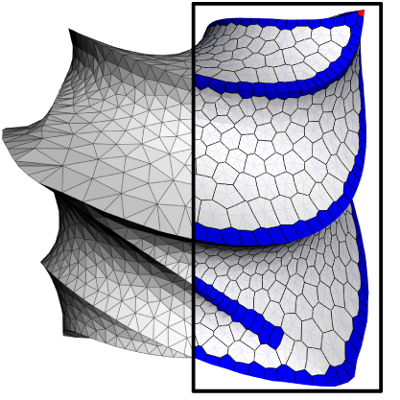Purpose and context
The aim of this work is to provide an efficient approach for implicit surface meshing, with curvature adaptivity and sharp features handling

(a) (b) (c) (d) (e)
Figure 1 : Overview of our approach : (a) The input implicit surface (here obtained from the Lucy 3D model). (b) initial mesh. (c) mesh after topology refinement (d) mesh after geometric refinement (e) mesh after variational optimization
Methods
We introduce a novel meshing algorithm of implicit surfaces with a user-defined number of points, where the contribution is twofold: (i) we propose a meshing algorithm which captures
efficiently the topology and geometry of the given implicit surface, and (ii) an optimization algorithm, which improves the quality of the resulting mesh, both in terms of shape approximation quality and triangle aspect ratio. The initialization algo rithm is a Delaunay refinement method guided by two straightforward tests that provides a manifold mesh where the accuracy is fixed via a user defined coefficient. The optimization algorithm, based on vertex relaxation, is driven by variational and approximation quality criteria. The relaxation process deals simultaneously with the problems of implicit surface approximation and mesh quality. The resulting mesh is an accurate approximation of the shape geometry, with good triangle aspect ratios, and is guaranteed to be locally Delaunay conform. Distribution of the mesh vertices can either be uniform or adaptive to the local curvature on the implicit surface via a gradation parameter. See
Results

Figure 2 : Stanford Bunny


Figure 3 : an implicit twisted brick (shown in its dual version) and a twisted octahedron.

